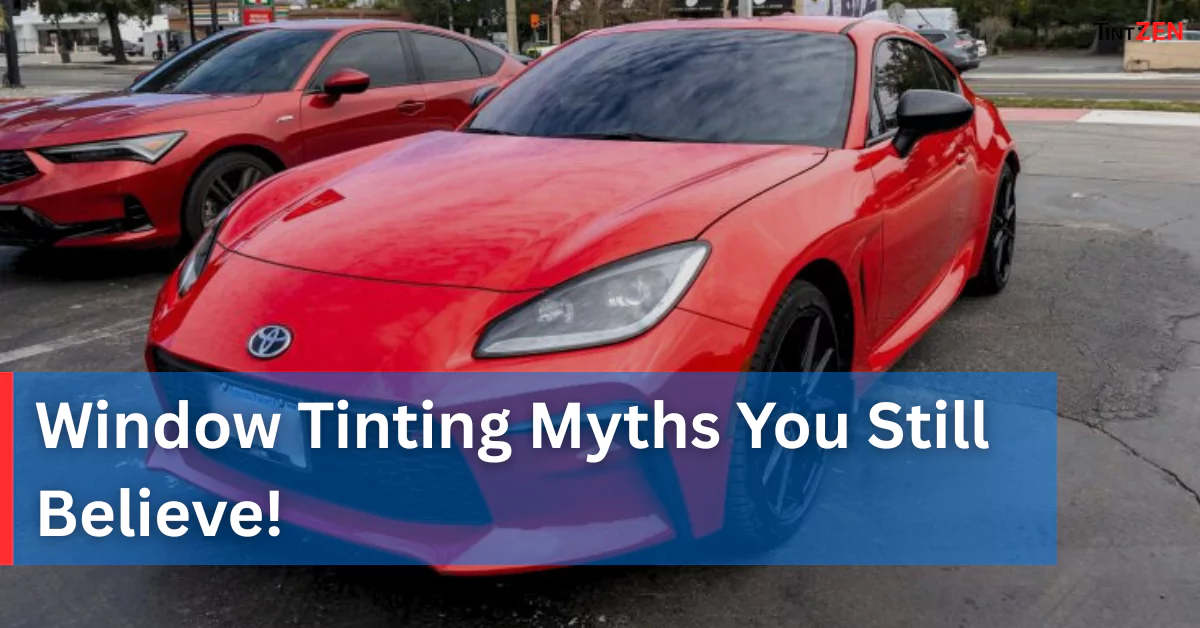When I first dipped into the world of car window tinting around my 5th year with it, I was hooked but lost in myths and fiction. Whether you’re new or on a go-around with the latest ceramic tint, the misconceptions can trip you up.
At TintZEN, with 25 years under their belt, they’ve heard every tale from the local community. I’ve learned it’s important to separate fact from fluff and make an informed decision. This isn’t just a service—it’s a misunderstood gem.
Let’s set the record straight and debunk the top myths in this blog post, keeping it simple, valuable, and real—no greatest hype, just clarity.
Top 5 Myths About Window Tinting
1. It’s More Than Just Looks
I used to think window tinting was all about that sleek, classy look—until I got it done at Accu Tint and realized how much more it offers. Sure, the vibe is sharp, but it also blocks up to 99% of ultraviolet rays with 3M window films, helping protect your skin, leather, and upholstery from sun damage.
On hot days, it keeps the interior cool, saves on air conditioning costs, and even protects my dog from the heat. I went with 3M Ceramic IR for its 95% infrared rejection at 5% tint, though the lighter 3M Crystalline still blocks 97% at just 20% tint.
Whether you want privacy, less glare, or to reduce fuel consumption, tinting delivers real practical benefits beyond the curb appeal—and that’s no myth.
2. Window Tinting is Illegal
I used to think window tinting was illegal—like you’d get pulled over just for having a tinted vehicle. But here’s the truth: tint laws change depending on where you live and how dark the tint is.
In states like Florida, 28% VLT is allowed on front windows, and 15% or even 6% on the rear depending on the car type. Even windshields can be tinted to the AS-1 line. At places like TintZEN or Apex Auto Performance in Maryland, real automotive window tint experts help you stay in compliance with local laws and choose legal options that still give your ride that sleek look—no myths, just facts.
3. Tint Will Cause Bubbles and Fading Over Time
Back in the day, I’d look at old cars with peeling tint and think, “Man, window tinting just doesn’t last—it’s all bubbles and fade.” But that’s a myth! With high-quality 3M films at places like TintZEN, they’re guaranteed for life—no bubble, no peel, no crack, no purple mess.
I’ve seen Accu Tint installers work their magic with proper techniques, using the right tools to ensure a smooth, pristine finish that stays beautiful. The technology has jumped significantly—ceramic and carbon options can withstand environmental factors and last around 10 years or longer with a warranty.
Forget the cheap $99 junk that leads to issues; professional installation and care make it confident, kicking misconception to the curb with peace of mind.
4. Tinted Windows Make it Hard to See At Night
A lot of folks worry that tinted windows make visibility tough at night, but that’s a misconception! Modern 3M window films are actually engineered to reduce glare from the sun and bright headlights, ensuring you can still see clearly.
While a darker film can be a bit tricky for nighttime driving, the right tint percentage makes a big difference. At TintZEN, their experts help you choose the proper tint that fits your needs and budget, so you won’t be negatively affected when you hit the road.
Enjoy a stylish ride with exceptional clarity, even after dark!
5. Window Tinting is Too Expensive
Let’s change the idea that window tinting is an expensive luxury. While top-tier films like 3M Crystalline may cost more, I’ve found that tinting can be quite affordable and is truly an investment that saves money over time.
Picture this: in the summer, your car heats up, but with tinted windows, it requires less AC to cool down, lowering your gas and energy bills. It also protects your car’s interior from fading and cracking, reducing future repair costs and keeping furniture safe from harmful UV rays.
At TintZEN, they provide competitive pricing to match your needs and budget. A standard film for an average-sized vehicle is around $100, but higher-quality options can go upwards of $400. The best part? Those long-term benefits, like lower fuel consumption and better air conditioning efficiency, make it worth the investment. The upfront cost may seem tricky, but the savings add up significantly over time.
Does Window Tinting Mess with Your Gadgets?
I used to worry that window tinting might block my car’s electronics like GPS, Bluetooth, or cell phones, especially with keyless entry systems. But here’s the good news—modern ceramic and carbon-based tints do not affect signals at all.
Unlike older metallic-based tints that could interfere, the non-metallic ceramic option provides superior heat rejection and UV protection with zero interference. I’ve got Wi-Fi and GPS in my vehicle, and after choosing this, I get all the benefits without any issues. No more signal drivers dropping calls or losing maps—tinting ensures it all works perfectly.

